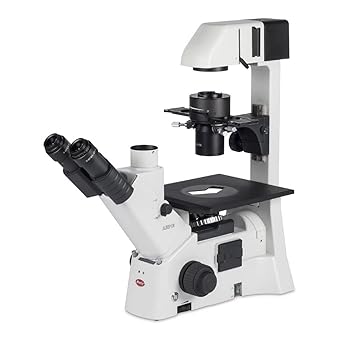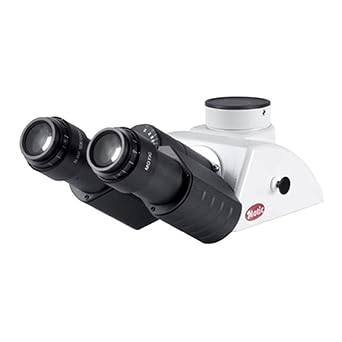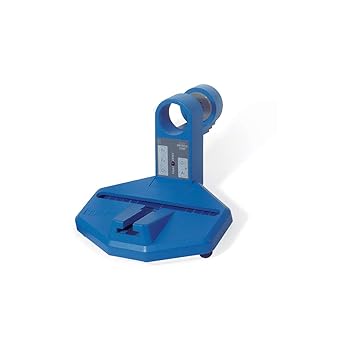
1100100200212 Series AE31 Inverted Trinocular Compound Microscope, Plan Objectives, 40x-400x Magnification, Brightfield, Phase-Contrast, Kohler Halogen Illumination, ELWD Condenser, Plain Stage, 100V-240V (110V Plug)
Brand: Motic
Out of stock
- Inverted compound microscope for observation of biological cultures or specimens within well plates, petri dishes, or vials in areas that require a longer working distance
- Trinocular viewing configuration with a Siedentopf binocular head that has a pair of 22mm 10x widefield high-eyepoint eyepieces and fixed inclination to reduce eye and neck strain, and a trinocular port that accepts a camera adapter (sold separately)
- Under-mounted, side-facing nosepiece with brightfield 4x, phase-contrast 10x, and LWD phase-contrast 20x and 40x CCIS plan achromatic objectives for color correction and improved focus over the entire range of the viewing field
- Upper brightfield and phase-contrast Kohler halogen illumination with rheostat and 0.30 NA ELWD condenser for clear examination and light control
- Plain stage with glass and metal inserts accommodates various types of samples, and coaxial nested coarse and fine focus knobs speed focusing
Description
The Motic 1100100200212 Series AE31 Inverted Trinocular Compound Microscope has a pair of 10x widefield high-eyepoint eyepieces, a trinocular port, an under-mounted side-facing nosepiece with one brightfield and three phase-contrast color-corrected infinity optical system (CCIS) plan achromatic objectives, Kohler halogen illumination, a 0.30 NA extra-long working-distance (ELWD) condenser, coaxial nested coarse and fine focus, and a plain stage with inserts. The trinocular viewing head has a Siedentopf binocular head with a pair of eyepieces with interpupillary adjustment and a fixed inclination to reduce eye and neck strain, and a trinocular port that accepts a camera adapter (sold separately). A Siedentopf binocular head enables the viewer to change the interpupillary distance without changing the tube length, eliminating the need to refocus the image. High-eyepoint eyepieces ease viewing for viewers wearing glasses. Dioptric adjustment accommodates individual eye-strength differences. A side-facing nosepiece eases changing objectives. Plan achromatic objectives provide color correction and focus over the entire range of the viewing field, have a longer working distance for improved focus when auxiliary components are utilized. The 20x and 40x objectives are long working-distance (LWD) objectives for viewing samples through thick glass plates and vessels. An inverted microscope is used in research, medical, and industrial laboratories for observation of biological specimens within vials or dishes that require a longer working distance. The microscope has upper (episcopic) brightfield and phase-contrast, Kohler illumination that reflects light off the specimen for enhanced visibility of opaque specimens. Brightfield (BF) illumination allows the specimen to absorb light, resulting in a dark image on a light background. Phase-contrast provides high contrast and visibility without the use of stains, allowing specimens to be observed in their natural state without being killed or fixed. A phase slider allows switching between brightfield and phase-contrast illumination. Kohler illumination focuses and centers the light path, providing optimum contrast and resolution. The halogen light source provides bright light in a concentrated path, and a rheostat controls the amount of light emanating from the lamp. Blue, green, and ground glass filters are included to modify the light to suit various specimens. The plain stage includes glass and metal inserts to accommodate various types of samples. Coaxial coarse and fine focus knobs are nested to speed focusing for left-and right-handed viewers, and tension adjustment ensures specimen stays focused during viewing. Microscope Head and Optics SpecificationsHeadTrinocular, SiedentopfMagnification range40x-400xLight split100:0/20:80Binocular head inclination45 degreesInterpupillary adjustment55 to 75mmEyepieces (22mm)WF10xNosepieceQuintuple, under-mounted, side-facingObjective, CCIS plan achromatic brightfield4xObjectives, CCIS plan achromatic phase-contrast10xObjectives, CCIS LWD plan achromatic phase-contrast20x, 40x Microscope Illumination and Stage SpecificationsFocus typeCoaxial coarse and fineWorking distance72mm with condenser; 231mm without condenserCondenser0.30 NA ELWDLight sourceHalogen with rheostat, 6V/30WIllumination typeReflected brightfield and phase-contrast KohlerStage typePlain with glass and metal insertsStage dimensions200 x 260mm (W x D)Power100V-240V (110V plug) W is width, the horizontal distance from left to right; D is depth, the horizontal distance from front to back. Microscopes are instruments used to enhance the resolution of an object or image. Types include compound, stereo, or digital. Compound microscopes use a compound optical system with an objective lens and an eyepiece. Stereo microscopes show object depth in a three-dimensional image. Digital microscopes are used to display an image on a monitor, rather than looking through a lens. Microscopes can have monocular (one), binocular (two), or trinocular (three) eyepieces, with varying magnification abilities. Magnification ability refers to the size of an image. Resolution, also known as resolvant power, refers to the clarity of the image. The interaction between field of view (FOV), numerical aperture (NA), and working distance (WD) determines resolution. Microscopes can control magnification through a fixed focus, or through a range of adjustments. They can also utilize LED, fluorescent, and mirror light sources to help control viewing capabilities. Microscopes are widely used in education, lab research, biology, metallurgy, engineering, chemistry, manufacturing, and in the medical, forensic science, and veterinary industries. Motic manufactures microscopes, microscope cameras, digital imaging products, and application software. The company, founded in 1988 and headquartered in Xiamen, China, is a subsidiary of Hong Kong-based Speed Fair Co. Ltd. and meets International Organization for Standardization (ISO) standards 9001 and 14000. What's in the Box? Motic 1100100200212 Series AE31 Inverted Trinocular Compound Microscope (2) WF10x eyepieces CCIS PL4x plan achromatic objective, brightfield CCIS PL PH10x plan achromatic objective, phase-contrast CCIS LWD PL PH20x plan achromatic objective, phase-contrast CCIS LWD PL PH40x plan achromatic objective, phase-contrast Phase centering telescope Phase slider Glass stage insert Metal stage insert Blue filter, 45mm Green filter, 45mm Ground glass filter, 45mm Hex key Dust cover Power cord
Product Details
| Package Dimensions ? | ? 27.9 x 27.1 x 13.2 inches; 0.71 ounces |
| Item model number ? | ? 1100100200212 |
| Date First Available ? | ? March 27, 2013 |
| Manufacturer ? | ? Motic Instruments |
| ASIN ? | ? B00C2FE3AE |
| Country of Origin ? | ? China |






